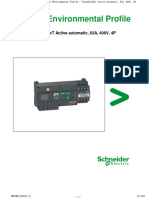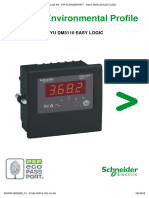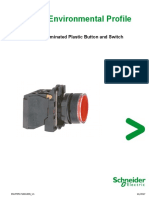Envpep1404008en V3
Envpep1404008en V3
Uploaded by
Richie FobbeoCopyright:
Available Formats
Envpep1404008en V3
Envpep1404008en V3
Uploaded by
Richie FobbeoOriginal Title
Copyright
Available Formats
Share this document
Did you find this document useful?
Is this content inappropriate?
Copyright:
Available Formats
Envpep1404008en V3
Envpep1404008en V3
Uploaded by
Richie FobbeoCopyright:
Available Formats
Product Environmental Profile
VARIABLE SPEED DRIVE ATV630 IP21 22KW 400V/480V
Altivar Process ATV600/900
ENVPEP1404008_V3 - SCHN-00722-V01.01-EN 11/2021
General information
Representative product VARIABLE SPEED DRIVE ATV630 IP21 22KW 400V/480V - ATV630D22N4
The main function of the Altivar Process product range is the speed control and variation of a
Description of the product synchronous, asynchronous or reluctance electric motor for fluid management and industrial
applications.
This range consists of products Altivar 630, Altivar 930 and Altivar 955 with ratings from 7.5 to 11
kW for operation on 200V/240V and ratings from 15 to 22 kW for operation on 400V/480V, 3-phase
Description of the range supplies IP21/UL type 1.
The environmental impacts of this referenced product are representative of the impacts of the
other products of the range which are developed with a similar technology.
To adapt the speed and torque of synchronous, asynchronous or reluctance motor to the
machine's operating point for 22 kW electric motors for fluid management and industrial
applications in IP21/UL type 1 conditions, at 380V to 480V rated 3-phase voltage supply.
Functional unit
Calculation of the environmental impacts is based on 10 years of product service lifetime. The
usage profile taken into account is 80% uptime in use phase at 75% loading rate and 20% uptime
in stand by phase.
Constituent materials
Reference product mass 17,46 kg including the product, its packaging and additional elements and accessories
PP Polypropylene - 0,7% PA Polyamide - 0,6% PBT Polybutylene
PE Polyethylene - 1% Terephtalate - 0,4%
PC Polycarbonate - 19,1% Aluminium - 14,4%
Miscellaneous - 0,4%
Steel - 13,9%
Paper - 0,6%
Various - 0,8%
Electronic components -
13,3% Iron - 11,5%
Cardboard - 16,3% Copper - 5,8%
Zinc - 0,5% Brass - 0,9%
Plastics 21,8%
Metals 47,0%
Others 31,4%
ENVPEP1404008_V3 - SCHN-00722-V01.01-EN 11/2021
Substance assessment
Products of this range are designed in conformity with the requirements of the RoHS directive (European Directive 2011/65/EU of 8 June
2011) and do not contain, or only contain in the authorised proportions, lead, mercury, cadmium, hexavalent chromium or flame retardants
(polybrominated biphenyls - PBB, polybrominated diphenyl ethers - PBDE) as mentioned in the Directive
Details of ROHS and REACH substances information are available on the Schneider-Electric Green Premium website
http://www2.schneider-electric.com/sites/corporate/en/products-services/green-premium/green-premium.page
Additional environmental information
The VARIABLE SPEED DRIVE ATV630 IP21 22KW 400V/480V presents the following relevent environmental aspects
The variable speed drive saves up to 50% energy by optimising the operating cycles of the machines used for fluid
Design
applications with Altivar Process.
Manufacturing Manufactured at a Schneider Electric production site ISO14001 certified
Weight and volume of the packaging optimized, based on the European Union's packaging directive
Packaging weight is 2996,2 g, consisting of It consists of recyclable cardboard (94%), paper (2%), dessicant dryer
Distribution
(3%) and polyethylene film (1%).
Product distribution optimised by setting up local distribution centres
Installation The product does not require any installation operation.
Use The product does not require special maintenance operations.
End of life optimized to decrease the amount of waste and allow recovery of the product components and materials
This product contains Electronic cards (1721 g), cables (550 g), Electrolyte capacitors (525 g), LCD (25 g) and
batteries (2.9 g) that should be separated from the stream of waste so as to optimize end-of-life treatment.
The location of these components and other recommendations are given in the End of Life Instruction document which
End of life is available on the Schneider-Electric Green Premium website
http://www2.schneider-electric.com/sites/corporate/en/products-services/green-premium/green-premium.page
Based on “ECO’DEEE recyclability and recoverability calculation method”
Recyclability potential: 77% (version V1, 20 Sep. 2008 presented to the French Agency for Environment
and Energy Management: ADEME).
Environmental impacts
Reference life time 10 years
Product category Other equipments - Active product
The disposal of the packaging materials are accounted for during the installation phase (including transport to
Installation elements
disposal).
The product is in active phase 80% of the time at 75% loading rate with a power use of 439 W (Supply
Use scenario voltage is 400V, switching frequency is 4 kHz, and loading rate is 75%) and in stand-by phase 20% of the
time with a power use of 20 W, for 10 years.
Geographical
Europe
representativeness
Technological The main function of the Altivar Process product range is the speed control and variation of a synchronous,
representativeness asynchronous or reluctance electric motor for fluid management and industrial applications.
Manufacturing Installation Use End of life
Electricity Mix; AC;
Energy model used Electricity Mix; AC; Electricity Mix; AC;
consumption mix, at
Energy model used: China consumption mix, at consumption mix, at
consumer; < 1kV; EU-
consumer; < 1kV; EU-27 consumer; < 1kV; EU-27
27
ENVPEP1404008_V3 - SCHN-00722-V01.01-EN 11/2021
Compulsory indicators VARIABLE SPEED DRIVE ATV630 IP21 22KW 400V/480V - ATV630D22N4
Impact indicators Unit Total Manufacturing Distribution Installation Use End of Life
Contribution to mineral resources depletion kg Sb eq 3,67E-02 3,58E-02 0* 0* 8,37E-04 0*
Contribution to the soil and water acidification kg SO2 eq 1,40E+02 7,59E-01 0* 0* 1,39E+02 0*
3-
Contribution to water eutrophication kg PO4 eq 5,47E+00 2,62E-01 2,37E-03 0* 5,21E+00 1,81E-03
Contribution to global warming kg CO2 eq 1,85E+04 1,57E+02 2,25E+00 0* 1,84E+04 4,46E+00
kg CFC11
Contribution to ozone layer depletion 4,48E-03 1,86E-05 0* 0* 4,46E-03 0*
eq
Contribution to photochemical oxidation kg C2H4 eq 6,62E+00 5,50E-02 7,34E-04 0* 6,57E+00 0*
Resources use Unit Total Manufacturing Distribution Installation Use End of Life
Net use of freshwater m3 6,39E+01 1,60E+01 0* 0* 4,79E+01 0*
Total Primary Energy MJ 3,75E+05 2,84E+03 0* 0* 3,72E+05 0*
100%
90%
80%
70%
60%
50%
40%
30%
20%
10%
0%
Contribution to Contribution to Contribution to Contribution to Contribution to Contribution to Net use of Total Primary
mineral the soil and water water global warming ozone layer photochemical freshwater Energy
resources acidification eutrophication depletion oxidation
depletion
Manufacturing Distribution Installation Use End of life
Optional indicators VARIABLE SPEED DRIVE ATV630 IP21 22KW 400V/480V - ATV630D22N4
Impact indicators Unit Total Manufacturing Distribution Installation Use End of Life
Contribution to fossil resources depletion MJ 1,91E+05 1,80E+03 3,16E+01 0* 1,89E+05 2,06E+01
Contribution to air pollution m³ 8,11E+05 2,25E+04 9,58E+01 0* 7,88E+05 1,81E+02
Contribution to water pollution m³ 7,90E+05 1,77E+04 3,70E+02 0* 7,71E+05 8,43E+02
Resources use Unit Total Manufacturing Distribution Installation Use End of Life
Use of secondary material kg 2,45E+00 2,45E+00 0* 0* 0* 0*
Total use of renewable primary energy resources MJ 2,67E+04 1,17E+02 0* 0* 2,66E+04 0*
Total use of non-renewable primary energy resources MJ 3,48E+05 2,72E+03 0* 0* 3,46E+05 0*
Use of renewable primary energy excluding renewable
MJ 2,67E+04 5,98E+01 0* 0* 2,66E+04 0*
primary energy used as raw material
Use of renewable primary energy resources used as
MJ 5,76E+01 5,76E+01 0* 0* 0* 0*
raw material
Use of non renewable primary energy excluding non
MJ 3,48E+05 2,54E+03 0* 0* 3,46E+05 0*
renewable primary energy used as raw material
Use of non renewable primary energy resources used
MJ 1,83E+02 1,83E+02 0* 0* 0* 0*
as raw material
Use of non renewable secondary fuels MJ 0,00E+00 0* 0* 0* 0* 0*
Use of renewable secondary fuels MJ 0,00E+00 0* 0* 0* 0* 0*
Waste categories Unit Total Manufacturing Distribution Installation Use End of Life
Hazardous waste disposed kg 7,08E+02 6,87E+02 0* 0* 0* 2,05E+01
Non hazardous waste disposed kg 6,88E+04 8,69E+01 0* 0* 6,87E+04 0*
Radioactive waste disposed kg 5,61E+01 6,36E-02 0* 0* 5,60E+01 0*
ENVPEP1404008_V3 - SCHN-00722-V01.01-EN 11/2021
Other environmental information Unit Total Manufacturing Distribution Installation Use End of Life
Materials for recycling kg 1,53E+01 1,37E+00 0* 2,94E+00 0* 1,10E+01
Components for reuse kg 0,00E+00 0* 0* 0* 0* 0*
Materials for energy recovery kg 7,83E-01 0* 0* 0* 0* 7,83E-01
Exported Energy MJ 8,84E-03 5,73E-04 0* 8,27E-03 0* 0*
* represents less than 0.01% of the total life cycle of the reference flow
Life cycle assessment performed with EIME version EIME v5.9.1, database version 2016-11 in compliance with ISO14044.
The use phase is the life cycle phase which has the greatest impact on the majority of environmental indicators (based on compulsory
indicators).
According to this environmental analysis, proportionality rules may be used to evaluate the impacts of other products of this range.
To extrapolate the impact to another product from the range, apply the following extrapolation rules to each indicator per life cycle stage:
MANUFACTURING(i) = Mass of (product+packaging) in grams / Mass of (reference product+reference packaging) in grams
DISTRIBUTION (i) = Mass of (product+packaging) in grams / Mass of (reference product+reference packaging) in grams
INSTALLATION (i) = Mass of (packaging) in grams / Mass of (reference packaging) in grams
USE (i) = Power dissipated in Watts / Power dissipated of the reference product in Watts
END OF LIFE (i) )= Mass of (product) in grams / Mass of (reference product) in grams
TOTAL (i) = Σ Life Cycle Stages (i)
Please note that the values given above are only valid within the context specified and cannot be used directly to draw up the
environmental assessment of an installation.
Registration number : SCHN-00722-V01.01-EN Drafting rules PCR-ed3-EN-2015 04 02
Verifier accreditation N° VH39
Information and reference
Date of issue 11/2021 www.pep-ecopassport.org
documents
Validity period 5 years
Independent verification of the declaration and data, in compliance with ISO 14025 : 2010
Internal External X
The PCR review was conducted by a panel of experts chaired by Philippe Osset (SOLINNEN)
PEP are compliant with XP C08-100-1 :2016
The elements of the present PEP cannot be compared with elements from another program.
Document in compliance with ISO 14025 : 2010 « Environmental labels and declarations. Type III environmental
declarations »
Schneider Electric Industries SAS
Country Customer Care Center
http://www.se.com/contact
35, rue Joseph Monier
CS 30323
FR- 92500 Rueil Malmaison Cedex
RCS Nanterre 954 503 439
Capital social 896 313 776 €
www.schneider-electric.com Published by Schneider Electric
SCHN-00722-V01.01-EN © 2021 - Schneider Electric – All rights reserved 11/2021
You might also like
- Bus Ticket Invoice 1721114712Document2 pagesBus Ticket Invoice 1721114712Piyush Dubey33% (9)
- Contract Guernsey Tax Summary To PDFDocument1 pageContract Guernsey Tax Summary To PDFMancus MariusNo ratings yet
- Omnesys Algorithm Strategies List PDFDocument9 pagesOmnesys Algorithm Strategies List PDFPuneet Kinra100% (1)
- Product Environmental Profile: Variable Speed Drive Atv630 Ip21 90Kw 400V/480VDocument5 pagesProduct Environmental Profile: Variable Speed Drive Atv630 Ip21 90Kw 400V/480VRadwan AL TrougNo ratings yet
- Envpep1508003en V2Document5 pagesEnvpep1508003en V2Kapil GalwaniNo ratings yet
- Files 1Document5 pagesFiles 1David MorenoNo ratings yet
- ENVPEP1801009ENDocument5 pagesENVPEP1801009ENakramNo ratings yet
- ENVPEP1501009ENDocument5 pagesENVPEP1501009ENJosé Luis Morán HernándezNo ratings yet
- Envpep1802008 V1Document5 pagesEnvpep1802008 V1RaviNo ratings yet
- Product Environmental Profile: Powertag Acti9Document5 pagesProduct Environmental Profile: Powertag Acti9Diego OliveiraNo ratings yet
- Product Environmental Profile: Easergy Cl110Document5 pagesProduct Environmental Profile: Easergy Cl110Hà Huy TấnNo ratings yet
- ENVPEP2304003ENDocument6 pagesENVPEP2304003ENgogoNo ratings yet
- FTD00917 - TT01-TT03 PCR3 - CODDE - v14 - ENVPEP2012004 - V1Document6 pagesFTD00917 - TT01-TT03 PCR3 - CODDE - v14 - ENVPEP2012004 - V1sobrelawebNo ratings yet
- Env Pep 120606 enDocument5 pagesEnv Pep 120606 endaniel sinagaNo ratings yet
- PEP Ecopassport SCHN-00299-V02.01-ENDocument5 pagesPEP Ecopassport SCHN-00299-V02.01-ENNicusor MiertescuNo ratings yet
- FilesDocument5 pagesFilesd82k6pnvdhNo ratings yet
- ENVPEP1501010ENDocument6 pagesENVPEP1501010ENlolaCH AndresNo ratings yet
- Envpep1409017 V2Document5 pagesEnvpep1409017 V2Kazim ThakurNo ratings yet
- ENVPEP2202028ENDocument5 pagesENVPEP2202028ENgogoNo ratings yet
- Product Environmental Profile: 3 TH110 Wireless Thermal Sensor - Self Powered + 3 Energy Harvesting & Fixing KitsDocument6 pagesProduct Environmental Profile: 3 TH110 Wireless Thermal Sensor - Self Powered + 3 Energy Harvesting & Fixing KitsHà Huy TấnNo ratings yet
- Env Pep 1512018 enDocument5 pagesEnv Pep 1512018 enSara TariqNo ratings yet
- PEP Ecopassport SCHN-00901-V01.01-EN - 1Document5 pagesPEP Ecopassport SCHN-00901-V01.01-EN - 1cesar antonio arriaga carrizalesNo ratings yet
- Product Environmental Profile1Document5 pagesProduct Environmental Profile1Hernan Vallenilla Rumildo MixNo ratings yet
- Voltmeter Data SheetDocument5 pagesVoltmeter Data Sheetsrg powerNo ratings yet
- DPN VigiDocument5 pagesDPN Vigiromnick.bugal.tekniqNo ratings yet
- Ammeter Data SheetDocument5 pagesAmmeter Data Sheetsrg powerNo ratings yet
- ENVPEP2407026ENDocument5 pagesENVPEP2407026ENJulio LeónNo ratings yet
- SCHN 00984 V01.01 enDocument4 pagesSCHN 00984 V01.01 enmomemoy158No ratings yet
- Envpep1710010en V1Document5 pagesEnvpep1710010en V1CristhianNo ratings yet
- Internal PEP ENVPEP1406018 - V2Document5 pagesInternal PEP ENVPEP1406018 - V2herdiyanto herdiyantoNo ratings yet
- PEP Ecopassport SCHN-01085-V01.01-ENDocument5 pagesPEP Ecopassport SCHN-01085-V01.01-ENgogo.ilNo ratings yet
- LGRP 01550 V01.02 enDocument5 pagesLGRP 01550 V01.02 enlolaCH AndresNo ratings yet
- Envpep2309009 V1Document5 pagesEnvpep2309009 V1Anikesh DessaiNo ratings yet
- Product Environmental Profile: Apacs+ Ahf216 Module APACS+ IO, Communication ModulesDocument5 pagesProduct Environmental Profile: Apacs+ Ahf216 Module APACS+ IO, Communication ModulesHernan Vallenilla Rumildo MixNo ratings yet
- Envpep060406en V3Document5 pagesEnvpep060406en V3zetamieNo ratings yet
- PEP Ecopassport SCHN-01033-V01.01-ENDocument4 pagesPEP Ecopassport SCHN-01033-V01.01-ENMiguel Angel Quispe ChoqueNo ratings yet
- Internal PEP ENVPEP1610004 - V2 - 3Document5 pagesInternal PEP ENVPEP1610004 - V2 - 3laxmanjat9999No ratings yet
- ENVPEP110202ENDocument5 pagesENVPEP110202ENckhg978No ratings yet
- ENVPEP2208015ENDocument4 pagesENVPEP2208015ENAhmed MostafaNo ratings yet
- Product Environmental Profile: FBM214/216 Termination Assembly Termination AssembliesDocument5 pagesProduct Environmental Profile: FBM214/216 Termination Assembly Termination AssemblieswisnuNo ratings yet
- Pep Envpep1304020 - V3Document4 pagesPep Envpep1304020 - V3hovanchienautoNo ratings yet
- Internal Pep Envpep2310016 - v1Document5 pagesInternal Pep Envpep2310016 - v1IBRAHIM AL-SURAIHINo ratings yet
- ENVPEP2204004ENDocument5 pagesENVPEP2204004ENgogo.ilNo ratings yet
- Internal PEP ENVPEP110229EN - V4Document5 pagesInternal PEP ENVPEP110229EN - V4eletroandrade1980No ratings yet
- Product Environmental Profile: Switch 63A 2P BiconnectDocument5 pagesProduct Environmental Profile: Switch 63A 2P BiconnectMadusanka WeebeddaNo ratings yet
- Envpep1712005en V1Document5 pagesEnvpep1712005en V1whbb.obhpr74No ratings yet
- ENVPEP1412003Document5 pagesENVPEP1412003south adventureNo ratings yet
- PEP Ecopassport SCHN-00212-V02.01-ENDocument5 pagesPEP Ecopassport SCHN-00212-V02.01-ENthắng hữuNo ratings yet
- Envpep110230en V3Document5 pagesEnvpep110230en V3rubberrio1No ratings yet
- Product Environmental Profile: Logic Controller - Modicon M241Document5 pagesProduct Environmental Profile: Logic Controller - Modicon M241ryanNo ratings yet
- Envpep100401en V0Document4 pagesEnvpep100401en V0mesbah mNo ratings yet
- Roduct Nvironmental Rofile: MCCB Thermal Magnetic DPX 160Document4 pagesRoduct Nvironmental Rofile: MCCB Thermal Magnetic DPX 160ngolo shunguNo ratings yet
- Pep Hager TXM620D Hage-00513-V01.01-En 942020Document4 pagesPep Hager TXM620D Hage-00513-V01.01-En 942020cosmigossNo ratings yet
- ENVPEP110103EN - V0 (Web)Document4 pagesENVPEP110103EN - V0 (Web)ISGENo ratings yet
- SB5000SE DEN1618 V11webDocument2 pagesSB5000SE DEN1618 V11webDaniel Andrei ŞerbanNo ratings yet
- Environmental Product Declaration: IP 72L50-740 NR BS 3550 CL2 M60 ANTDocument15 pagesEnvironmental Product Declaration: IP 72L50-740 NR BS 3550 CL2 M60 ANTpetarurosNo ratings yet
- DAS-WH108PA 395W-415W (182m) BifacialDocument2 pagesDAS-WH108PA 395W-415W (182m) BifacialMalinaNo ratings yet
- A9L15593 DATASHEET WW en-WWDocument2 pagesA9L15593 DATASHEET WW en-WWDudan SofwatullahNo ratings yet
- LGRP 00744 V01.01 enDocument4 pagesLGRP 00744 V01.01 enWilliam AcevedoNo ratings yet
- Envpep1511005 V2Document5 pagesEnvpep1511005 V2Jesús BenitezNo ratings yet
- Opti Drive Adv Tech ManualDocument61 pagesOpti Drive Adv Tech ManualhalezerNo ratings yet
- 1LAC000003 DistTrHandbook PDFDocument92 pages1LAC000003 DistTrHandbook PDFarmandoa71565100% (1)
- Handbook of Microwave Component Measurements: with Advanced VNA TechniquesFrom EverandHandbook of Microwave Component Measurements: with Advanced VNA TechniquesRating: 4 out of 5 stars4/5 (1)
- 2 Recording of Partnership Formation (FS) Illustrative - 2024Document2 pages2 Recording of Partnership Formation (FS) Illustrative - 2024ordaszymon33No ratings yet
- Budgetary Control and Responsibilty AccountingDocument34 pagesBudgetary Control and Responsibilty AccountingnicahNo ratings yet
- الادارة الهندسيةDocument7 pagesالادارة الهندسيةhassanien mohammedNo ratings yet
- 2 Storey ResidentialDocument18 pages2 Storey ResidentialThabisoNo ratings yet
- Evershed Kroll White Consulting Ledgers Upto 19.02.24Document22 pagesEvershed Kroll White Consulting Ledgers Upto 19.02.24MILINDSWNo ratings yet
- Product Disclosure SheetDocument3 pagesProduct Disclosure SheetshamsulNo ratings yet
- Ts Grewal Solutions Class 12 Accountancy Vol 1 Chapter 1 Company Accounts FinancialDocument27 pagesTs Grewal Solutions Class 12 Accountancy Vol 1 Chapter 1 Company Accounts Financialnaharpurab09No ratings yet
- Agribusiness Management W3 W4Document16 pagesAgribusiness Management W3 W4Wynnie RondonNo ratings yet
- Week 2 - Lecture - Multinational Corporations and HRMDocument35 pagesWeek 2 - Lecture - Multinational Corporations and HRMyayalim2008No ratings yet
- Top 29 Hook IdeasDocument13 pagesTop 29 Hook IdeastobiascrudeliNo ratings yet
- HomeWork Advance Accounting CH 13 - Steven Hartono Tumegah - 13202110014Document5 pagesHomeWork Advance Accounting CH 13 - Steven Hartono Tumegah - 13202110014georgius gabrielNo ratings yet
- Pile Capacity Assessment - OHDocument3 pagesPile Capacity Assessment - OHOmer HayatNo ratings yet
- Dimayuga TV Repair ShopDocument6 pagesDimayuga TV Repair ShoptakycabrejasNo ratings yet
- Prosave Death Claim FormDocument5 pagesProsave Death Claim FormzakiNo ratings yet
- Soal Us B.ing Paket B 2122Document11 pagesSoal Us B.ing Paket B 2122Ramdhan GumilarNo ratings yet
- Profit Maximization: B-Pure MonopolyDocument11 pagesProfit Maximization: B-Pure MonopolyChadi AboukrrroumNo ratings yet
- Pre-Requisites of Economic Development:: Question No. 1Document4 pagesPre-Requisites of Economic Development:: Question No. 1raheel khanNo ratings yet
- BMAK Lectures III Part5Document52 pagesBMAK Lectures III Part5theodoreNo ratings yet
- London Energy Brokers' Association Otc Energy Volume Report - April 2021Document4 pagesLondon Energy Brokers' Association Otc Energy Volume Report - April 2021Ilya ZiminNo ratings yet
- Technical EffortDocument4 pagesTechnical Efforta27912371No ratings yet
- Comprehensive Report On Indian Metal Cutting Machine Tool Industry - 2019Document73 pagesComprehensive Report On Indian Metal Cutting Machine Tool Industry - 2019Dr-Prashanth GowdaNo ratings yet
- Assignment Two Instructions S2 2021Document2 pagesAssignment Two Instructions S2 2021Dat HuynhNo ratings yet
- Falcon FX Journal & Performance Analyser (V2)Document43 pagesFalcon FX Journal & Performance Analyser (V2)Villaca KeneteNo ratings yet
- To Find SAC-Services Accounting Codes For GST in IndiaDocument2 pagesTo Find SAC-Services Accounting Codes For GST in Indiaaditya701No ratings yet
- Aec 2101 Production Economics - 0Document4 pagesAec 2101 Production Economics - 0Kelvin MagiriNo ratings yet
- Limit Switch Mounting PlateDocument1 pageLimit Switch Mounting PlateHimindra ChaaubeNo ratings yet
- Soal Uas SMK Xii Semester 1 2019 2020Document5 pagesSoal Uas SMK Xii Semester 1 2019 2020Wulandari Agung MaEzraNo ratings yet

























































































